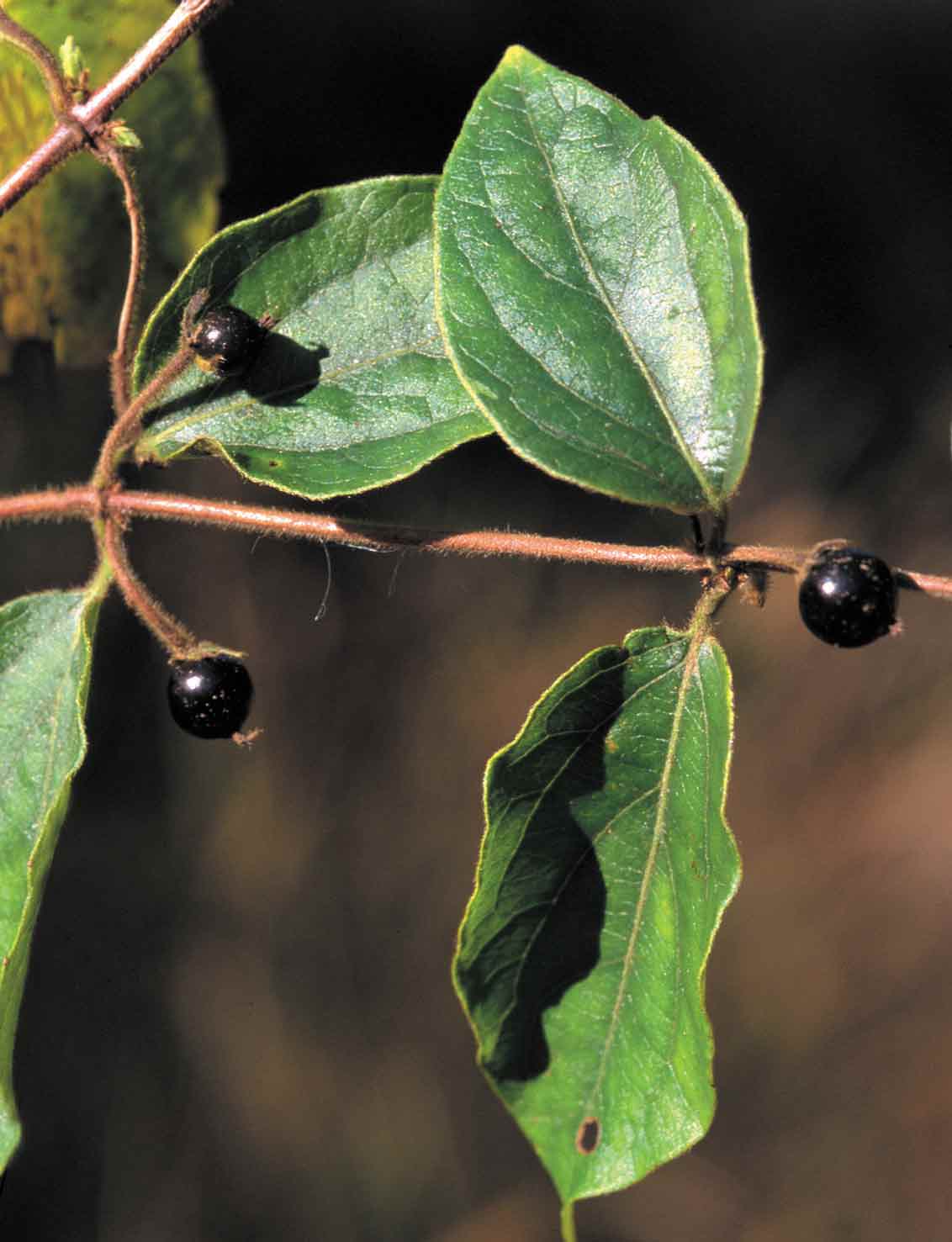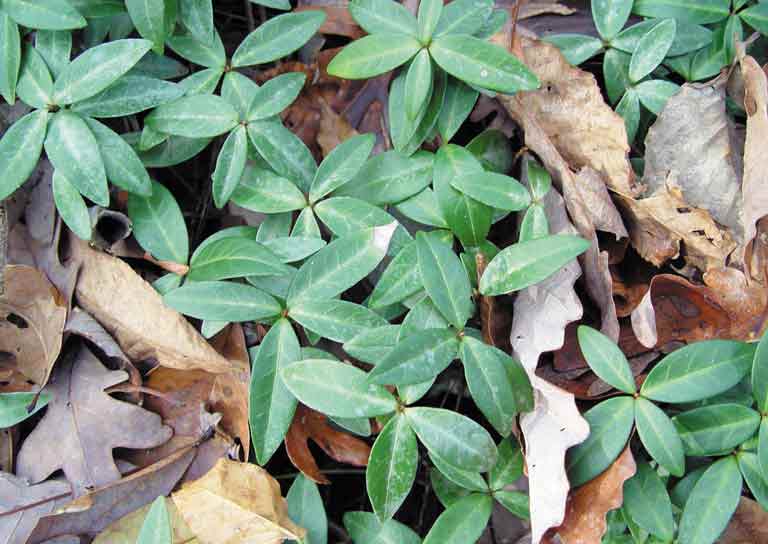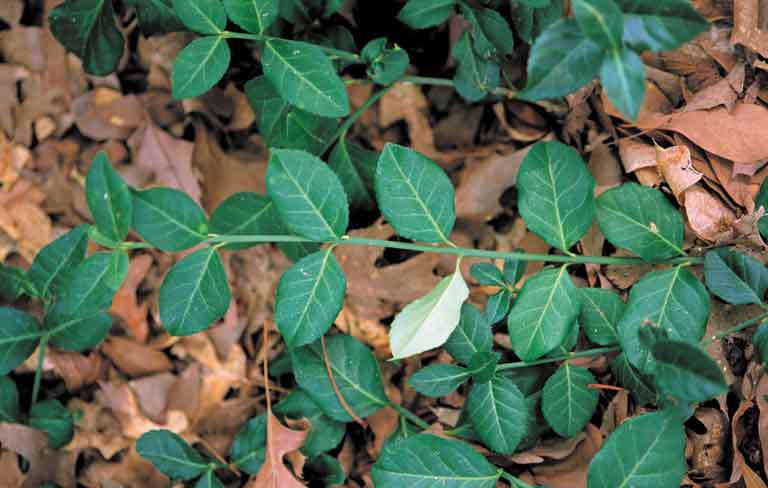Wintertime Invasive Plant Attack
As winter sets in across Indiana there are many things that you can do in your woods like cutting firewood, forest stand improvement or even marking boundary lines. An often-overlooked project is controlling invasive plants. Wintertime is a fantastic time to control invasive plants and there are certain ones that are easy to find and control.
Woody Vines:
 Japanese Honeysuckle (Lonicera japonica) is a perennial, evergreen vine that can be found climbing over other vegetation or trailing out through the woods. The leaves are opposite, pubescent and oval. It invades into disturbed areas, edges and even forest floors. In the winter, if the temperature climbs up over 50 degrees Fahrenheit you can apply glyphosate at 1.5% to 3% v/v with ¼ - ½ % non-ionic surfactant if the herbicide does not already contain surfactant and will do an excellent job killing Japanese honeysuckle. This is a wonderful time of year to treat Japanese honeysuckle since it often climbs over native plants which are dormant and not impacted by glyphosate in the winter.
Japanese Honeysuckle (Lonicera japonica) is a perennial, evergreen vine that can be found climbing over other vegetation or trailing out through the woods. The leaves are opposite, pubescent and oval. It invades into disturbed areas, edges and even forest floors. In the winter, if the temperature climbs up over 50 degrees Fahrenheit you can apply glyphosate at 1.5% to 3% v/v with ¼ - ½ % non-ionic surfactant if the herbicide does not already contain surfactant and will do an excellent job killing Japanese honeysuckle. This is a wonderful time of year to treat Japanese honeysuckle since it often climbs over native plants which are dormant and not impacted by glyphosate in the winter.
 Periwinkle (Vinca minor) is an evergreen, somewhat woody, trailing vine that tends to form a dense groundcover. The leaves are opposite, lanceolate and waxy green. The plant can form dense mats and infest open areas and does extremely well in the understory of heavily shaded forests. Vines tend to root at nodes making it hard to pull up by hand. On warm winter days over 50 degrees Fahrenheit you can spray Periwinkle with at 3% v/v mix of glyphosate and water. The leaves are very waxy so make sure the glyphosate you use has a surfactant included. If not add ¼ to ½% non-ionic surfactant to help spread out the water and penetrate the waxy surface of the leave. Garlon 4 (Triclopyr) at 3% v/v can also be used with a surfactant and constant agitation of your backpack sprayer.
Periwinkle (Vinca minor) is an evergreen, somewhat woody, trailing vine that tends to form a dense groundcover. The leaves are opposite, lanceolate and waxy green. The plant can form dense mats and infest open areas and does extremely well in the understory of heavily shaded forests. Vines tend to root at nodes making it hard to pull up by hand. On warm winter days over 50 degrees Fahrenheit you can spray Periwinkle with at 3% v/v mix of glyphosate and water. The leaves are very waxy so make sure the glyphosate you use has a surfactant included. If not add ¼ to ½% non-ionic surfactant to help spread out the water and penetrate the waxy surface of the leave. Garlon 4 (Triclopyr) at 3% v/v can also be used with a surfactant and constant agitation of your backpack sprayer.
 Winter Creeper (Euonymus fortune) is an evergreen shrub and climbing vine that forms a dense groundcover and quickly climbs trees and rocks with clinging aerial roots. The leaves are opposite, thick, dark green or green-white variegated on green stems. This plant can be treated in the winter when the temperature is over 50 degrees Fahrenheit with a 3% v/v solution of glyphosate and water with ¼ to ½% non-ionic surfactant if surfactant is not included in the herbicide. Garlon 4 (Triclopyr) at 3% v/v can also be used with a surfactant and constant agitation of your backpack sprayer. With the waxy leaf the surfactant is critical in getting the herbicide into the leaf. For large vines climbing up trees, you can cut and treat the cut surface with a 50% v/v solution of glyphosate and water.
Winter Creeper (Euonymus fortune) is an evergreen shrub and climbing vine that forms a dense groundcover and quickly climbs trees and rocks with clinging aerial roots. The leaves are opposite, thick, dark green or green-white variegated on green stems. This plant can be treated in the winter when the temperature is over 50 degrees Fahrenheit with a 3% v/v solution of glyphosate and water with ¼ to ½% non-ionic surfactant if surfactant is not included in the herbicide. Garlon 4 (Triclopyr) at 3% v/v can also be used with a surfactant and constant agitation of your backpack sprayer. With the waxy leaf the surfactant is critical in getting the herbicide into the leaf. For large vines climbing up trees, you can cut and treat the cut surface with a 50% v/v solution of glyphosate and water.
Woody Shrubs:
If you can identify invasive woody shrubs in the winter it is a great time to kill them. Shrubs such as Bush Honeysuckle (Lonicera spp.), Autumn Olive (Elaeagnus unbellata), Privet (Ligustrum japonicum) and Burning bush (Euonymus alatus) are all good targets in the winter especially if you want to try your hand at a basal bark application of herbicide. You can apply Garlon 4 (Triclopyr) at 20% mixed with a basal oil and apply it directly to the lower 8-12 inches of the stem all the way around and down to the root collar. Do not flood the ground around the stem. Start up high and let it run down the stem and spread around. Triclopyr is often sold as Garlon 4 or you can buy Pathfinder II which is a premixed triclopyr and a basal oil. Search the web for these products. Basal bark application of herbicide can be done throughout the winter, even below freezing if there is no snow on
the ground.
Controlling some invasive plants in the winter can be enjoyable work without the added stress of the heat and humidity, and spiders and ticks to bug you. Make sure you always read and follow the herbicide label directions and be able to identify your target plants or speak to a local professional before treating the species listed above. Treating these invasive plants in the winter when most of our native plants are dormant is a great way to reduce potential damage to surrounding native plants and start getting a handle on the invasive plants on your property.
Dan Shaver is the Project Director for The Nature Conservancy’s Brown County Hills Project and President of the Woodland Steward Institute in Indiana. He has a Forestry degree from Purdue University and is a licensed pesticide applicator.
